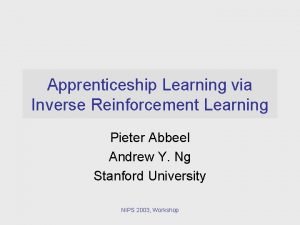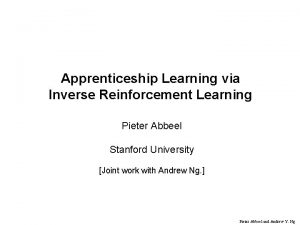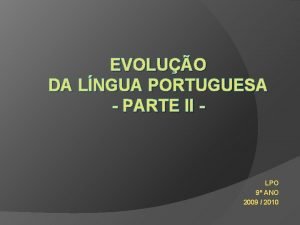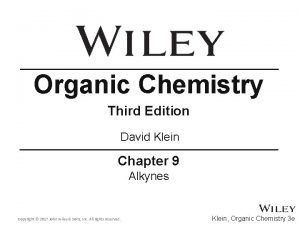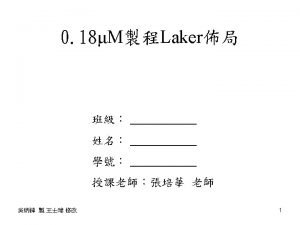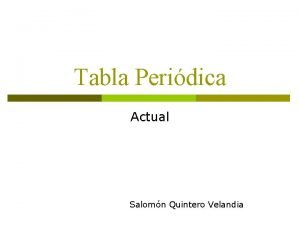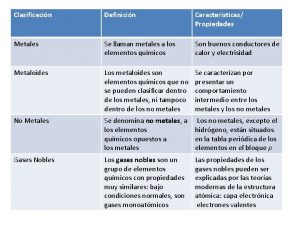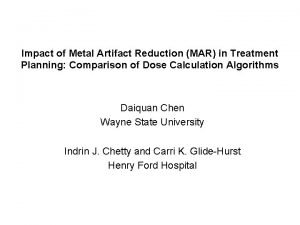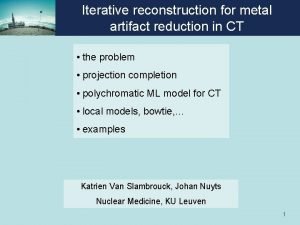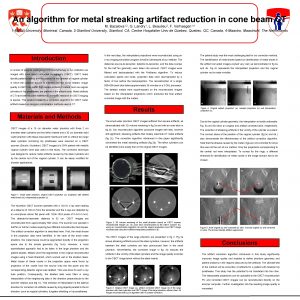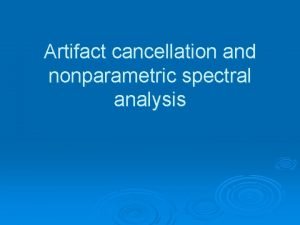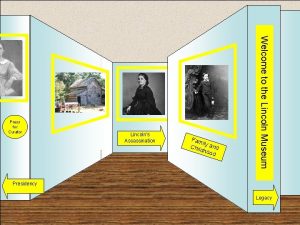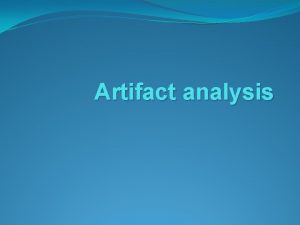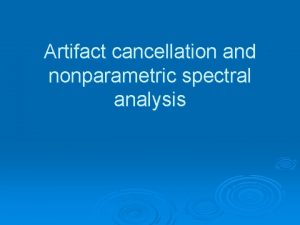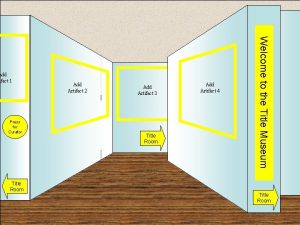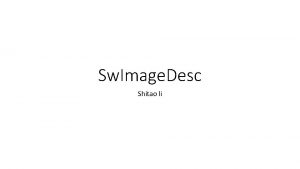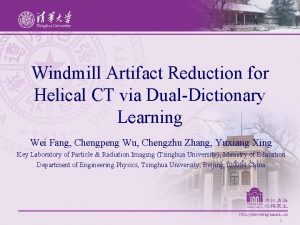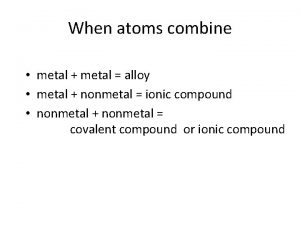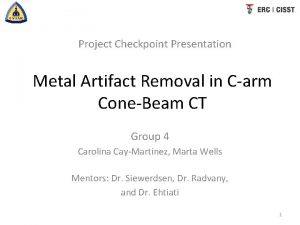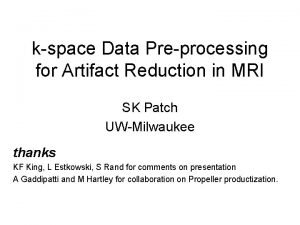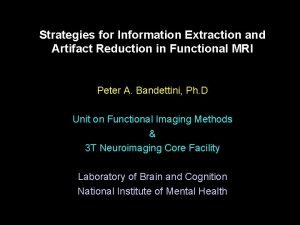CT Metal Artifact Reduction via ImageDomain Learning Lars



















- Slides: 19

CT Metal Artifact Reduction via Image-Domain Learning Lars Gjesteby, Hongming Shan, Qingsong Yang, Ge Wang Biomedical Imaging Center, CBIS/BME/So. E Rensselaer Polytechnic Institute November 19, 2017

Metal Artifacts • Metallic/dense objects cause severe metal artifacts • Existing metal artifact reduction (MAR) algorithms are imperfect • Relevant to medical imaging and airport scans of luggage • Smart techniques (machine learning/deep learning/CNN/ etc. ) can improve MAR

Metal Artifact Reduction • Metal objects corrupt CT images § Beam-hardening, scatter, noise • Projection completion 1 -3 • Iterative reconstruction 4 • Image-based post-processing 5 • Image quality remains insufficient (RT planning 6) 1. W. Kalender et al. , Radiology, 164(2), 1987. 2. M. Bal and L. Spies, Medical Physics, 33(8), 2006. 3. E. Meyer et al. , Medical Physics, 37(10), 2010 (Referred to as NMAR) 4. J. Stayman et al. , IEEE Trans. Med. Imag. , 31(10), 2012. 5. O. Watzke et al. , European Radiology, 14(5), 2004. 6. C. Reft, et al. , Medical Physics 30(6), 2003. 7. L. Gjesteby et al. , IEEE Access, 4, 2016 (Literature review) NMAR [3]

Proton Therapy • Energy lost by charged particles is inversely proportional to the square of their velocity • Precise localization of tumor is essential to ensure successful treatment

Data Domain Image Domain

Superiority Principle of Deep Learning • Train a convolutional neural network (CNN) on various types of artifacts • Take advantage of initial correction by proven MAR algorithms (NMAR) • Do no worse than the state-of-the-art • More inputs, better quality (conclusions from Prof. Yu’s group) State-of-the-art MAR results CNN More artifact reduction; Better image quality

Data Generation • • • Voxelized phantoms from the Visible Human Project: pelvis and spine regions Industrial-grade CT simulator (Cat. Sim, GE Global Research Center) Fan-beam geometry • • • 120 k. Vp, 300 m. A, 720 views Metal-free (ground truth) Titanium-added Ø NMAR algorithm applied • 60 image slices, 512 x 512 Ø 100 k 48 x 48 patches for training; 15 k for testing/validation

Learning in the Image Domain Ø 3 x 3 kernel size Ø Number of filters denoted by n … Input image: Already with correction from NMAR algorithm Output image: Further MAR through CNN: Five convolution and five deconvolution layers Supervised learning: Ground truth from simulation and/or experiments … • • Ø Batch normalization (BN) in the first three layers Ø Re. LU for activation

Truth Image Generated Output Image Loss Tuning Truth Feature Perceptual Loss Output Feature Truth Image Adversarial Loss CNN Generator VGG Network Tuning Discriminator CNN with WGAN

Experiments • CNN-MSE § MSE loss function • CNN-WGAN-VGG § VGG perceptual loss in the WGAN framework • CPCA-WGAN-VGG § VGG perceptual loss in the WGAN framework with a modified generator (contracting path convolutional autoencoder)

Testing Loss Curves

Spinal Fixation Rods Metal-free Truth NMAR CNN-MSE MSE: 0. 0903 SSIM: 0. 3590 PSNR: 10. 4454 Uncorrected CPCA-WGAN-VGG MSE: 0. 0092 SSIM: 0. 7228 PSNR: 20. 3856 MSE: 0. 0065 SSIM: 0. 7600 PSNR: 21. 8702 CNN-WGAN-VGG MSE: 0. 0104 SSIM: 0. 7085 PSNR: 19. 8411

Enlarged ROIs Metal-free Truth NMAR CNN-MSE Uncorrected CPCA-WGAN-VGG CNN-WGAN-VGG

Hip Prostheses NMAR Metal-free Truth MSE: 0. 1156 SSIM: 0. 3431 PSNR: 9. 3687 Uncorrected CPCA-WGAN-VGG MSE: 0. 0149 SSIM: 0. 6371 PSNR: 18. 2712 CNN-MSE MSE: 0. 0109 SSIM: 0. 6783 PSNR: 19. 6452 CNN-WGAN-VGG MSE: 0. 0147 SSIM: 0. 6357 PSNR: 18. 3168

Enlarged ROIs Metal-free Truth NMAR CNN-MSE Uncorrected CPCA-WGAN-VGG CNN-WGAN-VGG

MAR-CNN Training with Pseudo Truth

Pilot Results (IP Pending at RPI) Metal-free Truth NMAR (CNN Input) Uncorrected CNN-MSE CNN-WGAN-VGG

Discussions & Conclusion • Deep learning helps recover anatomical structures and tissue types when existing MAR algorithms are insufficient • Image domain methods have merits • Pseudo-truth could be powerful • Data and image domains will be combined in the future

Thank You! Biomedical Imaging Center Principal Investigator: Ge Wang Wenxiang Cong Guang Li Hongming Shan Ruibin Feng Tao Xu Qingsong Yang Matthew Getzin Lars Gjesteby Fenglei Fan Qing Lyu
 Apprenticeship learning via inverse reinforcement learning
Apprenticeship learning via inverse reinforcement learning Apprenticeship learning via inverse reinforcement learning
Apprenticeship learning via inverse reinforcement learning Via crucis via lucis
Via crucis via lucis Via positiva and via negativa
Via positiva and via negativa Via luchis
Via luchis Marcha hicopoda
Marcha hicopoda Via erudita e via popular
Via erudita e via popular Dissolving metal reduction
Dissolving metal reduction Diagram of the states of matter
Diagram of the states of matter Characteristics of metals
Characteristics of metals Dp periodic table
Dp periodic table Melting point of diamond
Melting point of diamond Metal 1 metal 2
Metal 1 metal 2 Non metals and uses
Non metals and uses Pure substances on the periodic table
Pure substances on the periodic table When a metal reacts with a nonmetal the metal will
When a metal reacts with a nonmetal the metal will Grupo b tabla periódica
Grupo b tabla periódica Blanch def
Blanch def Propiedades y características de los elementos
Propiedades y características de los elementos Non metal examples
Non metal examples
